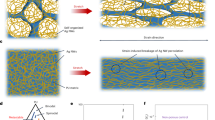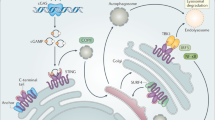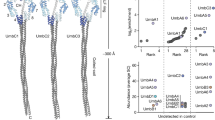Abstract
Antimicrobial peptides are an important component of the innate response in many species. Here we describe the isolation of the gene Dermcidin, which encodes an antimicrobial peptide that has a broad spectrum of activity and no homology to other known antimicrobial peptides. This protein was specifically and constitutively expressed in the sweat glands, secreted into the sweat and transported to the epidermal surface. In sweat, a proteolytically processed 47–amino acid peptide was generated that showed antimicrobial activity in response to a variety of pathogenic microorganisms. The activity of the peptide was maintained over a broad pH range and in high salt concentrations that resembled the conditions in human sweat. This indicated that sweat plays a role in the regulation of human skin flora through the presence of an antimicrobial peptide. This peptide may help limit infection by potential pathogens in the first few hours following bacterial colonization.
This is a preview of subscription content, access via your institution
Access options
Subscribe to this journal
Receive 12 print issues and online access
$209.00 per year
only $17.42 per issue
Buy this article
- Purchase on Springer Link
- Instant access to full article PDF
Prices may be subject to local taxes which are calculated during checkout




Similar content being viewed by others
References
Gallo, R. L. et al. Syndecans, cell surface heparan sulfate proteoglycans, are induced by a proline-rich antimicrobial peptide from wounds. Proc. Natl Acad. Sci. USA 91, 11035–11039 (1994).
Harder, J., Bartels, J., Christophers, E. & Schroder, J. M. A peptide antibiotic from human skin. Nature 387, 861 (1997).
Frohm, M. et al. The expression of the gene coding for the antibacterial peptide LL-37 is induced in human keratinocytes during inflammatory disorders. J. Biol. Chem. 272, 15258–15263 (1997).
Hancock, R. E. & Lehrer, R. Cationic peptides: a new source of antibiotics. Trends Biotechnol. 16, 82–88 (1998).
Jones, D. E. & Bevins, C. L. Defensin-6 mRNA in human Paneth cells: implications for antimicrobial peptides in host defense of the human bowel. FEBS Lett. 315, 187–192 (1993).
Harder, J., Bartels, J., Christophers, E. & Schroder, J. M. Isolation and characterization of Human β-Defensin-3, a novel human inducible peptide antibiotic. J. Biol. Chem. 276, 5707–5713 (2000).
Hipfel, R., Schittek, B., Bodingbauer, Y. & Garbe, C. Specifically regulated genes in malignant melanoma tissues identified by subtractive hybridization. Br. J. Cancer 82, 1149–1157 (2000).
Todorov, P. et al. Characterization of a cancer cachectic factor. Nature 379, 739–742 (1996).
Todorov, P. T., Deacon, M. & Tisdale, M. J. Structural analysis of a tumor-produced sulfated glycoprotein capable of initiating muscle protein degradation. J. Biol. Chem. 272, 12279–12288 (1997).
Cunningham, T. J. et al. Identification of a survival-promoting peptide in medium conditioned by oxidatively stressed cell lines of nervous system origin. J. Neurosci. 18, 7047–7060 (1998).
Cunningham, T. J., Jing, H., Wang, Y. & Hodge, L. Calreticulin binding and other biological activities of survival peptide Y-P30 including effects of systemic treatment of rats. Exp. Neurol. 163, 457–468 (2000).
Bals, R. Epithelial antimicrobial peptides in host defense against infection. Respir. Res. 1, 141–150 (2000).
Valore, E. V. et al. Human β-defensin-1: an antimicrobial peptide of urogenital tissues. J. Clin. Invest. 101, 1633–1642 (1998).
Sato, K., Kang, W. H., Saga, K. & Sato, K. T. Biology of sweat glands and their disorders. I. Normal sweat gland function. J. Am. Acad. Dermatol. 20, 537–563 (1989).
Okada, T., Konishi, H., Ito, M., Nagura, H. & Asai, J. Identification of secretory immunoglobulin A in human sweat and sweat glands. J. Invest. Dermatol. 90, 648–651 (1988).
Jones, A. P., Webb, L. M., Anderson, A. O., Leonard, E. J. & Rot, A. Normal human sweat contains interleukin-8. J. Leukoc. Biol. 57, 434–437 (1995).
Didierjean, L. et al. Biologically active interleukin 1 in human eccrine sweat: site-dependent variations in alpha/beta ratios and stress-induced increased excretion. Cytokine 2, 438–446 (1990).
Ahmed, A. A., Nordlind, K., Schultzberg, M. & Liden, S. Interleukin-1α- and β-, interleukin-6- and tumour necrosis factor-β-like immunoreactivities in chronic granulomatous skin conditions. Acta Derm. Venereol. 74, 435–440 (1994).
Wollina, U. et al. Eccrine sweat glands: expression of transforming growth factor-β and bone morphogenetic protein type I receptors and their intracellular signalling Smad proteins. Acta Derm. Venereol. 79, 183–186 (1999).
Myal, Y. et al. The prolactin-inducible protein (PIP/GCDFP-15) gene: cloning, structure and regulation. Mol. Cell. Endocrinol. 80, 165–175 (1991).
Fraki, J. E. Human skin proteases. Separation and characterization of two acid proteases resembling cathepsin B1 and cathepsin D and of an inhibitor of cathepsin B1. Arch. Dermatol. Res. 255, 317–330 (1976).
Fraki, J. E., Jansen, C. T. & Hopsu-Havu, V. K. Human sweat kallikrein. Biochemical demonstration and chromatographic separation from several other esteropeptidases in the sweat. Acta Derm. Venereol. 50, 321–326 (1970).
Goldman, M. J. et al. Human β-defensin-1 is a salt-sensitive antibiotic in lung that is inactivated in cystic fibrosis. Cell 88, 553–560 (1997).
Gallo, R. L. & Huttner, K. M. Antimicrobial peptides: an emerging concept in cutaneous biology. J. Invest. Dermatol. 111, 739–743 (1998).
Tossi, A., Sandri, L. & Giangaspero, A. Amphipathic α-helical antimicrobial peptides. Biopolymers 55, 4–30 (2000).
Hancock, R. E. & Lehrer, R. Cationic peptides: a new source of antibiotics. Trends Biotechnol. 16, 82–88 (1998).
Hipfel, R., Garbe, C. & Schittek, B. RNA isolation from human skin tissues for colorimetric differential display. J. Biochem. Biophys. Meth. 37, 131–135 (1998).
Schaumburg-Lever, G. Ultrastructural localization of lectin-binding sites in normal skin. J. Invest. Dermatol. 94, 465–470 (1990).
Acknowledgements
We thank T. Iftner and colleagues for DNA sequencing; M. Schwarz and colleagues for the use of radioisotopes and Phosphorimager; B. Fehrenbacher and H. Bischof for electron microscopy; A. Nordheim for mass spectrometry; E. Maczey for technical assistance; and P. Gött, T. Paul, M. Stark and F. Lang for discussions. Supported by the Fortüne-program of the Eberhard-Karls-University Tübingen (432-0-1), the Bundesministerium für Bildung und Forschung (IZKF, Fö01KS9602) and the Deutsche Forschungsgemeinschaft (SFB510).
Author information
Authors and Affiliations
Corresponding author
Supplementary information
Web Figure 1.
Sequence of DCD. (a) Full-length cDNA of DCD (458 bp). Exons, positions of introns, start and stop codons are indicated. UTS: untranslated regions. (b) Predicted amino acid sequence of DCD. (GIF 14 kb)
Rights and permissions
About this article
Cite this article
Schittek, B., Hipfel, R., Sauer, B. et al. Dermcidin: a novel human antibiotic peptide secreted by sweat glands. Nat Immunol 2, 1133–1137 (2001). https://doi.org/10.1038/ni732
Received:
Accepted:
Published:
Issue Date:
DOI: https://doi.org/10.1038/ni732
This article is cited by
-
In-depth metaproteomics analysis of tongue coating for gastric cancer: a multicenter diagnostic research study
Microbiome (2024)
-
Carbon nanomaterials for sweat-based sensors: a review
Microchimica Acta (2024)
-
Human secretory and excretory fluids, molecular constituents, and their biotherapeutic perspective against fungal pathogen Candida albicans
Rendiconti Lincei. Scienze Fisiche e Naturali (2023)
-
Skin immunity: dissecting the complex biology of our body's outer barrier
Mucosal Immunology (2022)
-
Skin Microbiome, Metabolome and Skin Phenome, from the Perspectives of Skin as an Ecosystem
Phenomics (2022)



